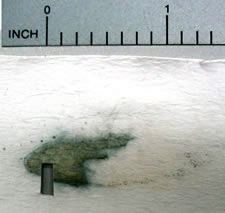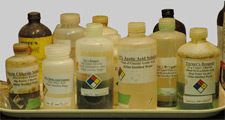Home | Glossary | Resources | Help | Contact Us | Course Map
Archival Notice
This is an archive page that is no longer being updated. It may contain outdated information and links may no longer function as originally intended.
Dithiooxamide Test
The Dithiooxamide Test (also known as the Rubeanic Acid Test) is a chemically specific chromophoric test for the presence of cuprous (copper-bearing) material. Copper-jacketed bullets represent a considerable percentage of ammunition evidence in criminal cases.
Copper is used in the following types of ammunition:
- Military and sporting jacketed bullets fabricated from gilding metal (a 90/10 copper/zinc alloy) or commercial bronze (a 95/5 copper/tin alloy)
- Rimfire bullets coated or plated with copper or brass (a 70/30 copper/zinc alloy)
- Revolver bullets with copper jackets
- Nickel-plated bullets, e.g. Silvertip bullets
As a result, the Dithiooxamide Test for cuprous material is frequently used because it detects copper-bearing material. The test identifies a bullet wipe or bullet splash caused by the copper-bearing particulate in the form of bullet jacket fragments found around the perimeter of a bullet hole. While the test is not particularly useful for distance determinations, it can detect residues consistent with the discharge of a firearm or the passage or impact of a copper-jacketed bullet.
Chemistry
The Dithiooxamide Test was published in Fritz Fiegls Spot Tests in Inorganic Analysis as a test for the detection of the presence of various metals. The color produced by the test would indicate the particular metal present.
The chemistry of the Dithiooxamide Test is comprised of the following process:
- Material from the perimeter of a suspected bullet hole is exposed to an ammonia solution.
- The same material is exposed to a solution of dithiooxamide dissolved in ethanol. If cuprous material is present, a copper complex with a characteristic color forms.
- A dark gray-green color indicates the presence of copper-bearing material in bullet wipe.
- A blue-pink color indicates the presence of nickel (e.g., silver-tipped bullets).
Reagents and Test Media
The following reagents and test media are required for the Dithiooxamide Test:
- Dithiooxamide
- Ethanol
- Concentrated ammonium hydroxide
- Distilled or deionized water
- White filter paper
- Known source of copper
- Cotton swabs
- Eye dropper bottle
Dithiooxamide Solution
- Prepare a 0.2 percent weight/volume solution of dithiooxamide in 100 percent ethanol.
- Store in a sealed container labeled according to laboratory protocol.
Ammonium Hydroxide Solution
- Prepare a 1:2 dilution of concentrated ammonium hydroxide using distilled or deionized water under a chemical hood.
- Store in a sealed container labeled according to laboratory protocol.
| Note: |
| There are numerous variations in the scientific literature for reagent strengths and the techniques for performing the Dithiooxamide Test. |
Test Procedure
The Dithiooxamide Test is carried out as follows:
- Confirm performance of all preliminary examinations and tests.
The Modified Griess Test must be performed before this test. - Place a test mark on the item to be tested.
Using a piece of known copper, place the mark well away from any holes to be tested. (Note: Apply the following steps to the test mark first to ensure the reagents are reacting properly and then apply to the questioned area.) - Position the area to be tested.
Place the test mark or suspected bullet hole face up on a clean uncontaminated surface. - Perform color test.
Place three drops of ammonium hydroxide solution on one half of folded filter paper.- Place the moistened half of the filter paper against the test area.
- Fold the dry half of filter paper over the moistened half. Using moderate pressure, press fingertips on the dry half of the filter paper for five to ten seconds.
- Turn the filter paper over.
- Place two or three drops of the dithiooxamide solution on the area that was in contact with the test area.
- Examine and interpret results.
Dark gray-green color indicates the presence of copper-bearing material.
Blue-pink color indicates the presence of nickel (e.g., silver-tipped bullets). - Dry test item.
Allow tested item to dry out before additional testing.
| Note: |
| Because this test is a lifting technique and is not carried out directly on the test item, it is inconsequential if the tested item is dark green or some other dark color. |
See the YouTube Terms of Service and Google Privacy Policy
Additional Online Courses
- What Every First Responding Officer Should Know About DNA Evidence
- Collecting DNA Evidence at Property Crime Scenes
- DNA – A Prosecutor’s Practice Notebook
- Crime Scene and DNA Basics
- Laboratory Safety Programs
- DNA Amplification
- Population Genetics and Statistics
- Non-STR DNA Markers: SNPs, Y-STRs, LCN and mtDNA
- Firearms Examiner Training
- Forensic DNA Education for Law Enforcement Decisionmakers
- What Every Investigator and Evidence Technician Should Know About DNA Evidence
- Principles of Forensic DNA for Officers of the Court
- Law 101: Legal Guide for the Forensic Expert
- Laboratory Orientation and Testing of Body Fluids and Tissues
- DNA Extraction and Quantitation
- STR Data Analysis and Interpretation
- Communication Skills, Report Writing, and Courtroom Testimony
- Español for Law Enforcement
- Amplified DNA Product Separation for Forensic Analysts



